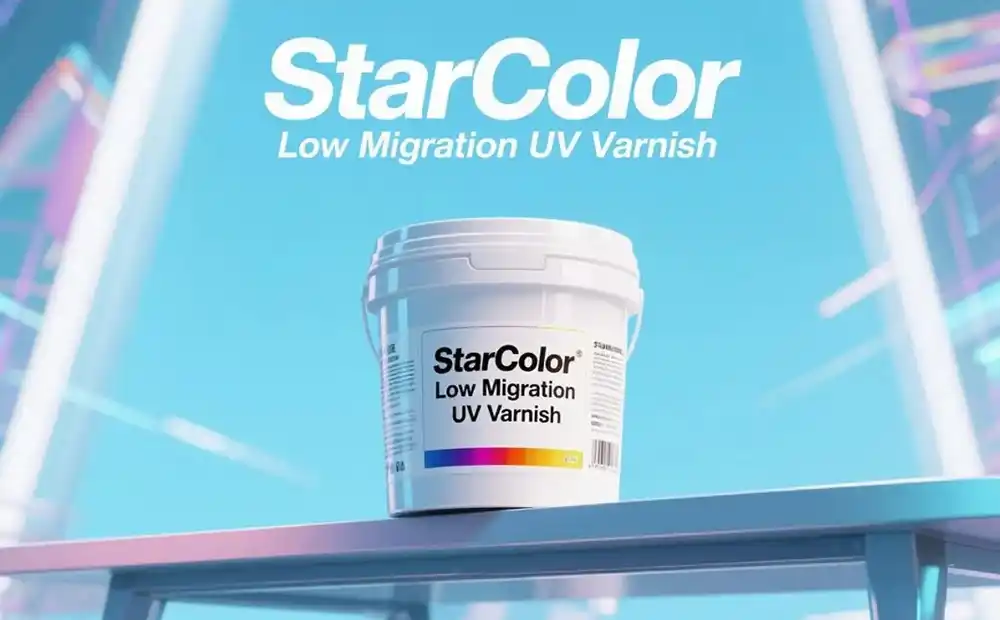 RU
RU
 EN
EN
 CN
CN

Position:HOME > Ink Knowledge > Other Printing Ink
Date: Jun 27 2025 From: Star Color Views:
Low migration UV varnishes are increasingly used in food, pharmaceutical, and cosmetic packaging due to their reduced risk of substance transfer (migration) into the packaged product. However, compliance with regulatory standards—especially from the FDA (U.S. Food and Drug Administration) and the EU (European Union)—is crucial to ensure product safety and market acceptance.
In this article, we explore whether low migration UV varnishes meet FDA and EU compliance requirements and what manufacturers and brand owners need to consider when choosing these coatings.
Low migration UV varnish is a type of ultraviolet-curable coating specifically formulated to minimize the migration of potentially harmful substances from the printed surface into the product—especially through indirect food contact. It uses carefully selected raw materials with high molecular weight and low diffusivity, combined with optimized curing technology.
When packaging is intended for food, cosmetics, or pharmaceuticals, any material that may come in contact with the product—even indirectly—must meet strict migration limits to protect human health. Regulatory compliance ensures that:
The packaging does not transfer unsafe levels of chemicals into the contents.
The packaging materials are legally acceptable in the market (U.S., EU, etc.).
Brand owners reduce legal risks and product recalls.
In the U.S., the FDA regulates food contact materials under Title 21 of the Code of Federal Regulations (CFR). Low migration UV varnishes may be considered indirect food additives and must comply with:
21 CFR 175.300: Resinous and polymeric coatings used as food-contact surfaces.
GRAS status: Some ingredients may be Generally Recognized As Safe.
Submissions via Food Contact Notifications (FCN) for new substances.
However, varnishes are not usually directly approved by the FDA. Compliance often depends on:
The use of listed substances.
Migration test results showing the absence of harmful transfer.
Use behind functional barriers in the packaging structure.
In the European Union, packaging materials are regulated by the Framework Regulation (EC) No. 1935/2004 and specific measures such as:
Commission Regulation (EU) No. 10/2011 on plastic materials and articles.
Swiss Ordinance (RS 817.023.21), often used as a reference for printing inks.
Good Manufacturing Practice (GMP) Regulation (EC) No. 2023/2006.
For a low migration UV varnish to be considered compliant in the EU, it should:
Contain only substances listed in EU positive lists or approved through risk assessment.
Pass migration testing under food-simulating conditions.
Be manufactured under GMP and documented with Statements of Compliance.
At StarColor, we formulate our Low Migration UV Varnishes using carefully selected monomers, oligomers, and photoinitiators that comply with FDA and EU standards. Our products are:
Independently tested for migration using accredited labs.
Manufactured in accordance with GMP protocols.
Accompanied by technical datasheets, test reports, and Statements of Composition to assist converters in regulatory documentation.
We support our clients with full traceability and guidance in achieving their compliance obligations for sensitive packaging applications.
Yes—Low Migration UV Varnishes can be compliant with FDA and EU regulations when formulated and tested correctly. StarColor's low migration varnishes are designed with safety and compliance in mind, helping converters meet market demands while reducing regulatory risk.
For technical datasheets, migration test reports, or regulatory inquiries, contact our team at StarColor-Ink.com.